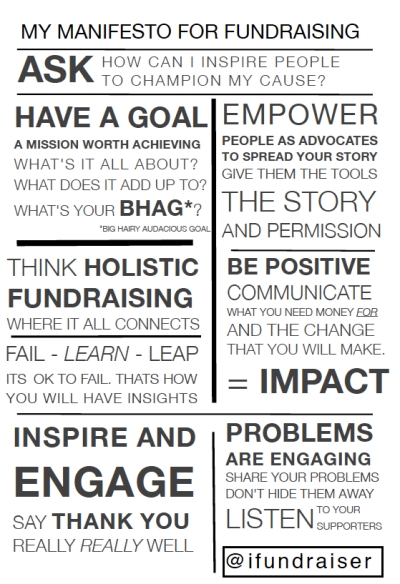What do you believe in? This is my manifesto for fundraising. Not all of you will subscribe to it. But it’s what I passionately believe in.
 1. The question to ask is not : how can I get the most money out of donors? It is : how can I inspire people to champion our cause? You need to treat your donors like customers who will recommend you to others. Why? Simple you do not know who they know in this connected world. This is the new “sticky marketing”. The social capital they have between them and their network is always going to be greater than the social capital you will ever have between your cause and their network. Set them loose and watch the ripple effect they initiate from engaging their network on your behalf.
1. The question to ask is not : how can I get the most money out of donors? It is : how can I inspire people to champion our cause? You need to treat your donors like customers who will recommend you to others. Why? Simple you do not know who they know in this connected world. This is the new “sticky marketing”. The social capital they have between them and their network is always going to be greater than the social capital you will ever have between your cause and their network. Set them loose and watch the ripple effect they initiate from engaging their network on your behalf.
That means bombarding tactics just to extract every possible penny out of donors are out.
2. To empower people as advocates to spread your story you need to give them the tools to tell the story (at SolarAid we use a kerosene lamp and a solar light), the story of course (clear and simple), and finally permission. Your fundraising team is suddenly ten times bigger.
3. Have a goal or a mission worth achieving. What’s it all about? What does it add up to? What’s your BHAG*? Above all you need this from your leadership. How else are you going to get people to really care about your cause ? How can you get every sinew of your organisation focused on achieving the mission. You need supporters to get excited enough to engage their own network of contacts.
*Big Hairy Audacious Goal
3. Inspire and engage. Tactics to inspire and engage people become obvious e.g. events you can talk to supporters to in person, saying thank you really really well, getting your donors to see your work first hand. Interestingly these activities often wouldn’t stand up to the silo ROI mentality that would just ask ‘how much money will this activity raise?‘. You will soon see that it opens up all sorts of opportunities.
4. Be positive. To inspire people to champion your cause to others is different to getting a response. So in my manifesto I don’t subscribe to what some have labelled poverty porn : messaging and images that are chosen to induce pity and guilt. Sure they get a response (and no doubt better tested against one that is less needy) but they are chosen with the sole objective to extract the most money out of their targets. If your objective is to inspire and engage by definition you will need a different message – one that conveys the solution. “But that’s what fundraisers have to do !” I hear some cry – “it’s our duty to convey the need“. Yes but need doesn’t mean needy. And need can mean what your need money for and the change (with your support) that you will make. This can still be extremely powerful and emotional. If you take into account the ripple effect this approach has it will make more money – so by the same principle it’s my duty as a fundraiser to apply it.
5. Think holistic fundraising, where it all connects, ROI only makes sense when you look at the entire fundraising programme. Don’t isolate and judge different areas, such as events vs trust fundraising based solely on ROI. How they interface is where the real magic happens: how a volunteer helps secure a trust grant; how an existing donor actively recruits other donors; how a supporter from an event introduces a major donor to your cause. That’s not an excuse to do whatever you like and not be accountable for results. You still need to determine how your fundraising programme links up strategically and focus on those that reinforce each other.
6. Problems are engaging. Share your problems and listen to your supporters don’t hide them away. Some of your supporters will have relevant skills, and insights to problems that you can’t see. Recently in the course of a week I was given the building blocks for a PR strategy for getting solar lights sold as the ‘must have Christmas gift’ and an engagement plan for a major corporate – all from networking and engaging people interested in helping solve the problems we faced.
7. Its ok to fail. When we admit to failure that’s when the brain kicks in and has insights on how to crack the problem. So do not fear failure, embrace it. Do not brush failure under the carpet as then you will not have the insights that follow. Fail – learn – leap.
That is my manifesto. What’s yours? Of course you can stick to the traditional methods targeting donors, playing every trick to lift response rates and average gifts – cutting out anything that doesn’t deliver a direct return on investment. That has no space in my manifesto.
That’s ok – as with politics it’s your choice what to believe in.


Hi Richard, I love this! Here’s something I blogged a little while ago that is as close as I can come to articulating my manifesto – it’s all about humanity: http://adriansalmon.wordpress.com/2013/12/06/donor-retention-is-simple/
Also, a couple of comments on two of your points, because I think what you are talking about is classic relationship fundraising, but it’s so often misunderstood:
1. Don’t bombard, but don’t go too far the other way and under-communicate! Some very wise words from a fundraiser called Melissa Graves on an email list I subscribe to: “If you ask only once and get a gift, then thank and wait 11 months to ask again – you have not cultivated that relationship, you have not continued to show the importance of your mission, you have not branded your logo on an envelope for a few weeks 5 times a year on their entryway table, you actually have decreased the chances the donor will give again.”
We ask up to 6 times a year, but we always make sure we are feeding back in between.
4. I think ‘Poverty porn’ only becomes so if you’re being at best disingenuous or at worst not telling the truth. We must not be afraid of showing the situation as it truly is. But if you’re using a ten year old picture that doesn’t show the truth of the moment now, then maybe time to think about the ethics of that?
But I think the absolute key thing is to always find ways to treasure the human scale of giving, that it is personal, it is emotional, it is one to one. And no matter the size of your organisation, to embrace the challenge of remaining human to your supporters.
LikeLike
Hi Adrian, thanks for your comments.
Yes we absolutely have to ask. I recall speaking to a farmer at an agricultural show at the height of foot and mouth and crisis in farming. So I asked him “I don’t suppose you like being asked to support charities like FARM-Africa at this time?”. “If you don’t ask I definitely wont give” was his reply. I used the story to convince senior staff we had to ask farmers (our closest supporters) despite the farming crisis. Then there is the way we think of donors. If we see them as ‘how I can extract money out of them?’, that’s different to ‘how can can inspire them so not only will they give they will tell others?’.
I so agree – the truth well told is the best fundraising story. Is that Ken speaking? And again it comes down to what your objective is – if its about a response then you can see why needy images pervade. Where as get someone engaged on your mission and who knows where it can lead.
You might enjoy this video which takes the micky out of some fundraising https://www.youtube.com/watch?v=xbqA6o8_WC0
Thanks again for taking the trouble to share your thoughts.
LikeLike
Wow – that is laugh-out-loud funny! Thanks for sharing 🙂 And yes, it’s certainly Ken speaking above – has ever a great fundraiser so often been misunderstood and had incorrect versions of his insights applied? But also Alan Clayton, and Jeff Brooks, and Tom Aherne – so many great fundraisers who get it and say the same thing 🙂 Have you read Jeff’s new book – The Money-Making Nonprofit Brand? Well worth getting hold of.
LikeLike
Not quite sure where it fits in, but I gave a presentation to the rest of the staff at my charity where I tried to show how services/fundraising/donors all fit together. My aim was to try and change our focus from fundraising (which everyone obsesses over from CEO to finance officer) to services. I explained that in an ideal world, donors would be able to give direct to the cause. The role of fundraising is to very clearly connect donors with the recipients of their generosity, and to be as small as needed. They’re not giving to us, they’re giving to the people who we help. Fundraising is essential (and I love it), but we only want to be as big as we have to be. We need to feel really connected with our cause (and in a titchy £500k charity, that should be easy), so we can really connect donors with our cause. The general love we seem to get from donors makes me think we’re doing ok. I just wish that a couple more of the (non-fundraising) staff would focus on services and less on fundraising!!
I guess in the above it’s “the change you will make = IMPACT” point. (Though I want to find an alternative word, impact (accurate) feels so well used it is becoming a tired sounding word.)
We don’t save lives or give support, our donors do. And that’s what we must keep reminding them, and ourselves!
LikeLike
Thanks Nick. I almost didn’t use the word Impact for the reason you state. Its often misused. For example measuring impact can sometimes show you could be doing something better (which is ok if your focus is a specific goal). I found when SolarAid set its mission goal to eradicate the kerosene lamp from Africa by 2020 then the whole organisation focused on the mission. And not just the organisation but those we engage with. Of course that included fundraising but also so much more. With a really powerful goal it becomes a ‘we’. Fundraisers connect people (this is blog thought I noted about just that https://ifundraiser.wordpress.com/2013/05/08/do-we-need-fundraisers/ )
LikeLike
This is great and exactly line-ups with the direction I think our philosophy needs to go in. Thank you!
LikeLiked by 1 person
Pingback: Confessions of a fundraiser | ifundraiser